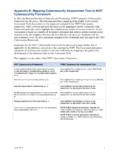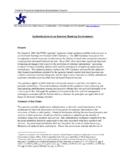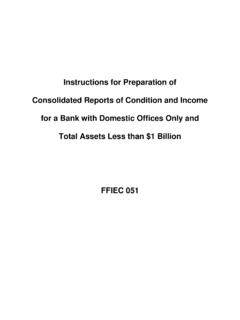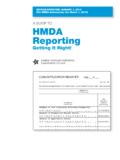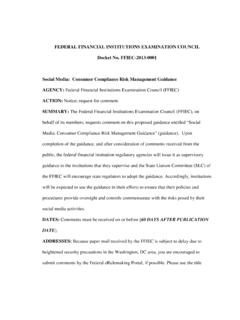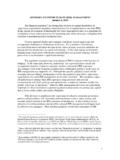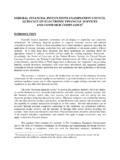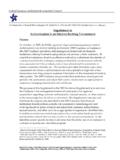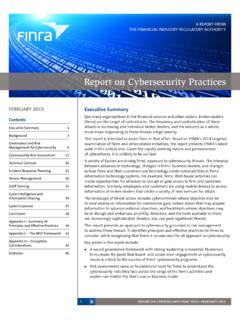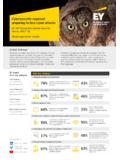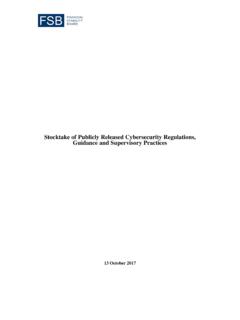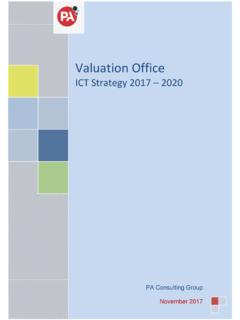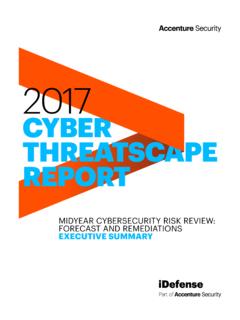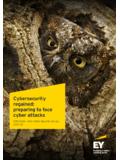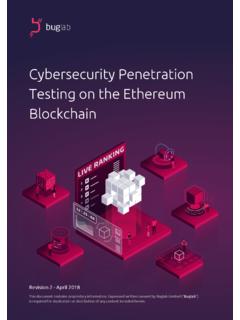Transcription of FFIEC CYBERSECURITY ASSESSMENT GENERAL …
1 FFIEC CYBERSECURITY ASSESSMENT . GENERAL OBSERVATIONS. During the summer of 2014, Federal Financial Institutions Examination Council ( FFIEC ). members 1 piloted a CYBERSECURITY examination work program ( CYBERSECURITY ASSESSMENT ) at over 500 community financial institutions to evaluate their preparedness to mitigate cyber risks. This document presents GENERAL observations from the CYBERSECURITY ASSESSMENT about the range of inherent risks and the varied risk management practices among financial institutions and suggests questions for chief executive officers and boards of directors to consider when assessing their financial institutions' CYBERSECURITY and preparedness. This document should not be construed as guidance. Related guidance appears at the end of the document. CYBERSECURITY INHERENT RISK. The CYBERSECURITY ASSESSMENT found that the level of CYBERSECURITY inherent risk varies significantly across financial institutions.
2 It is important for management to understand the financial institution's inherent risk to CYBERSECURITY threats and vulnerabilities when assessing CYBERSECURITY preparedness. CYBERSECURITY inherent risk is the amount of risk posed by a financial institution's activities and connections, notwithstanding risk-mitigating controls in place. A. financial institution's CYBERSECURITY inherent risk incorporates the type, volume, and complexity of operational considerations, such as connection types, products and services Questions to Consider offered, and technologies used. What types of connections does my financial Connection Types institution have? Financial institutions have numerous access How are we managing these connections in light points and use a variety of connection types, of the rapidly evolving threat and vulnerability including landscape? Do we need all of our connections? Would virtual private networks reducing the types and frequency of connections wireless networks improve our risk management?
3 Telnet, File Transfer Protocol How do we evaluate evolving cyber threats and local area network that directly connects to vulnerabilities in our risk ASSESSMENT process for other networks or to Internet service the technologies we use and the products and providers services we offer? bring your own device (BYOD) How do our connections, products and services offered, and technologies used collectively affect Because each connection represents a potential our financial institution's overall inherent entry point for attacks, it is important for CYBERSECURITY risk? management to consider whether the financial institution needs to maintain the types and frequency of all of its connections and which connections may be more vulnerable. For example, a financial institution's employees who use their own devices ( , BYOD) to connect to their organization's network may inadvertently expose their financial institution to malware. Products and Services Because cyber attackers develop techniques to target specific products and services, each product and service may introduce specialized CYBERSECURITY risks.
4 For example, stolen customer or employee credentials can be used by cyber criminals to commit wire transfer or automated 1. The FFIEC members are the Board of Governors of the Federal Reserve System, the Federal Deposit Insurance Corporation, the Office of the Comptroller of the Currency, the Consumer Financial Protection Bureau, the National Credit Union Administration, and the State Liaison Committee. FFIEC CYBERSECURITY ASSESSMENT GENERAL Observations | 1. clearing house (ACH) fraud at a financial institution offering ACH origination. Understanding the threats and techniques attackers use for each product and service helps management to identify, assess, and mitigate the financial institution's specific risks. Technologies Used Financial institutions use a vast array of technologies to support their customers and employees, including core systems, automated teller machines (ATM), Internet and mobile applications, and cloud computing.
5 Each type of technology introduces complexity and potential vulnerabilities. For example, financial institutions offering ATMs may be vulnerable to ATM cash-out scams and financial institutions offering Web-facing services may be vulnerable to distributed denial-of-service (DDoS) attacks. CYBERSECURITY PREPAREDNESS. In addition to CYBERSECURITY inherent risk, the CYBERSECURITY ASSESSMENT reviewed financial institutions' current practices and overall preparedness, focusing on the following: Risk management and oversight Threat intelligence and collaboration CYBERSECURITY controls External dependency management Cyber incident management and resilience Risk Management and Oversight Risk management and oversight involves governance, allocation of resources, and training and awareness of Questions to Consider employees. What is the process for ensuring Many boards discuss CYBERSECURITY with management ongoing and routine discussions by the board and senior management about when cyber attacks are widely reported or when the cyber threats and vulnerabilities to our financial institution experiences an attack.
6 Financial financial institution? institutions generally leverage existing information security policies and practices to address CYBERSECURITY How is accountability determined for managing cyber risks across our risks. Routinely discussing CYBERSECURITY issues in financial institution? Does this include board and senior management meetings will help the management's accountability for financial institution set the tone from the top and build business decisions that may introduce a security culture. Strong governance includes clearly new cyber risks? defined roles and responsibilities that assign What is the process for ensuring accountability to identify, assess, and manage ongoing employee awareness and CYBERSECURITY risks across the financial institution. effective response to cyber risks? While most financial institutions understand the need to train employees on CYBERSECURITY risk management, the outcome and benefits improve when training and awareness programs are kept current and are provided on a routine basis.
7 Employees can be a financial institution's first line of defense for many types of attacks, particularly social engineering attacks through phishing e-mails, which attempt to acquire sensitive information by masquerading as a trustworthy entity. FFIEC CYBERSECURITY ASSESSMENT GENERAL Observations | 2. Threat Intelligence and Collaboration Threat intelligence is the acquisition and analysis of information to identify, track, and predict cyber Questions to Consider capabilities, intentions, and activities that offer courses What is the process to gather and of action to enhance decision making. Threat analyze threat and vulnerability intelligence and collaboration includes gathering, information from multiple sources? monitoring, analyzing, and sharing information from How do we leverage this information multiple sources on cyber threats and vulnerabilities. to improve risk management practices? Many financial institutions rely on media reports and third-party service providers to gather information on What reports are provided to our board cyber events and vulnerabilities.
8 Financial institution on cyber events and trends? management is expected to monitor and maintain Who is accountable for maintaining sufficient awareness of CYBERSECURITY threats and relationships with law enforcement? vulnerabilities so they may evaluate risk and respond accordingly. Participating in information sharing forums ( , Financial Services Information Sharing and Analysis Center) is an important element of a financial institution's risk management processes and its ability to identify, respond to, and mitigate CYBERSECURITY threats and incidents. Likewise, many financial institutions share cyber threat information when prompted by law enforcement or regulators. Identifying points of contact for local or federal law enforcement improves a financial institution's ability to respond efficiently to threats before they manifest and to incidents once they occur. Most financial institutions maintain event logs to understand an incident or cyber event after it occurs.
9 Monitoring event logs for anomalies and relating that information with other sources of information broadens the financial institution's ability to understand trends, react to threats, and improve reports to management and the board. CYBERSECURITY Controls CYBERSECURITY controls can be preventive, detective, or corrective. Questions to Consider What is the process for determining and Most financial institutions implement preventive implementing preventive, detective, and controls to impede unauthorized access to their systems. corrective controls on our financial Preventive controls need to be reviewed and adjusted institution's network? when financial institutions change their information Does the process call for a review and technology (IT) environment, such as permitting update of controls when our financial unpatched devices to connect to their networks. institution changes its IT environment? Additionally, many financial institutions encrypt customer information in transit.
10 As a preventive control, What is our financial institution's process for classifying data and financial institutions may also consider classifying and determining appropriate controls based encrypting different types of sensitive data, including on risk? proprietary and important technical information. What is our process for ensuring that Most financial institutions have tools in place, such as risks identified through our detective anti-virus and anti-malware tools, to detect previously controls are remediated? identified attacks. In addition to these tools, financial institutions should routinely scan IT networks for vulnerabilities and anomalous activity, test systems for their potential exposure to cyber attacks, and remediate issues when identified. Most financial institutions have a process for implementing corrective controls to address previously identified vulnerabilities by installing patches on their primary IT system.
